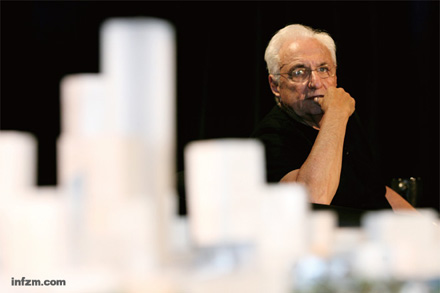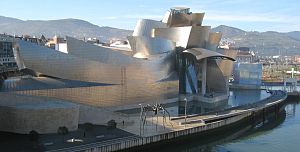The client-oriented visionary
- By Guo Jiali
 0 Comment(s)
0 Comment(s) Print
Print E-mail China.org.cn, June 1, 2012
E-mail China.org.cn, June 1, 2012
|
|
|
Frank Gehry [file photo] |
|
|
|
Guggenheim Museum[file photo] |
|
|
|
Walt Disney Concert Hall [file photo] |
Canadian-American Frank Gehry, who many consider to be an icon of modern architecture, is among four finalists in the competition to design the National Art Museum of China’s new site, which will be located in the area between the Bird’s Nest and China Science and Technology Hall.
Gehry's best-known works include the titanium-covered Guggenheim Museum in Bilbao, which has turned the small and unknown city in Spain into a world famous tourist destination over night.
Like a true innovator, Gehry can sometimes be known to cause controversy in his designs. He is dubbed the “Picasso in architecture” for his brave and unconventional use of materials, and for the way in which his buildings come together with unexpected elegance.
However, shock and awe is not this artist’s main goal. Gehry was asked in a recent interview with Nanfang Weekly what he finds to be the most difficult in this project. He said: “In my mind, whether the design can reflect both the client’s and my ideas at the same time is more important than its visual impact. I welcome more specific requirements and suggestions for revision, aiming to reach a consensus at last. Every work I design is the unique one by coordinating with each client.”
This may well prove to be a different experience than what onlookers in Beijing have had in recent years. Residents of the city are no stranger to radical and spectacular building designs, with many of its new landmarks being the works of famous Western architects, like Paul Andreu for the National Theatre, Jacques Herzog and Pierre de Meuron for the Beijing National Stadium (also known as the Bird’s Nest) and Rem Koolhaas for the new office building of China Central Television.
Still, while many expect to be amazed by a master at work, those who care about the future center that will house the country’s unique traditions are concerned how well the finalists, including Gehry, know about China and the Chinese culture.
In 2011, Gehry designed his first residential project in China, called the “Opus Hong Kong.” Now, at the age of 83, he has done a lot of homework to better understand China and Beijing for this new museum project. Compare to his work on the Guggenheim Museum, which took him 30 days to design, this time he has spent almost one year and visited Beijing several times.
His efforts in turn offered him a sense of the necessary items in his design, which will be both artistic and practical.
“To offer visitors a comfortable place to queue is important, which means visitors will not wait in a windy day or in a sauna summer day. I will work together with an excellent engineer in green energy in designing all the projects, including using green technologies to adjust the room temperature,” Gehry told Nanfang Weekly when he was asked how his design would address the weather conditions in Beijing.
Since Gehry has designed many art museums around the world, he knows well what’s important to artists. “A neutral white box is not always the best. As art industry in China is undergoing an explosive development, artists are in need of a museum of great significance to exhibit their works,” he said.
Gehry is now making efforts in understanding and adopting the culture elements in traditional China architecture, in order to present a brand new concept for the new art museum.
The veteran architect is also aware of challenges to designs that are new takes on old traditions. Speaking of whether he is worried about the acceptance of his design in the future, Gehry appeared confident: “Something what may look weird at the beginning will bring about a new concept to be recognition at last.”
Gehry, born in 1929, has been named "the most important architect of our age" by Vanity Fair, and his works are cited as being among the most important works of contemporary architecture in the 2010 World Architecture Survey.
Gehry's best-known works include the Guggenheim Museum in Bilbao, Spain, the MIT Stata Center in Cambridge, Massachusetts, and the Walt Disney Concert Hall in downtown Los Angeles.
The other three finalists for the National Art Museum of China project are Zaha Hadid from the U.K., Jean Nouvel from France and Moshe Safdie from Canada.









Go to Forum >>0 Comment(s)